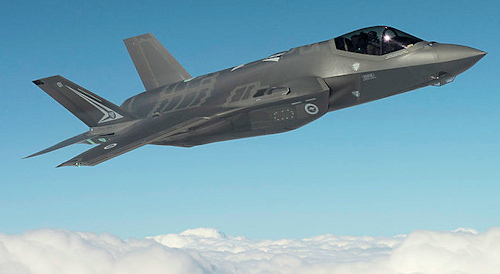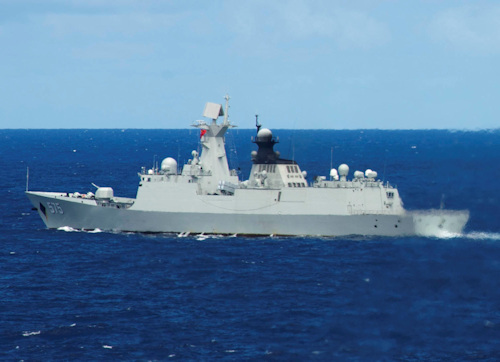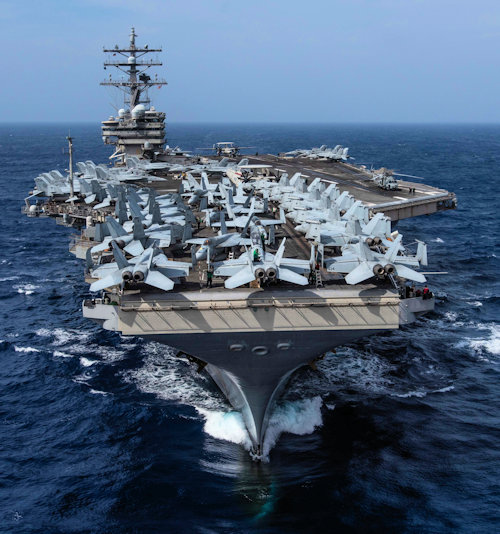According to the Chinese Academy of Military Sciences, national naval strategy must have the primary objective of expanding Chinese maritime power and therefore strategic interests. Indeed, from Beijing's point of view, the seas that bathe China are occupied by hostile forces and the chain of islands in the vicinity of the continent pose a threat to the maritime security of the country.
The 1996 Taiwan crisis constitutes a kind of watershed, when two groups of aircraft carriers of the US Navy blocked the straits: with this the operational impotence of the PLAN (People's Liberation Army Navy) was highlighted.
Since then, China has been working to ensure greater strategic depth, not only in the Indian Ocean through the South China Sea (with the base of Gwadar in Pakistan and Djibouti) but also beyond Taiwan and the Ryukiu islands, towards the eastern Pacific.
Just the muscle politics Beijing is pushing many Asian countries to form new alliances, with a view to China's containment policy.

Growing concerns about China's military potential have led many nations to cooperate, but it has also highlighted that, in addition to the fear of Chinese assertiveness, it is possible to establish fruitful collaboration in the security sector.
On May 25, 2007, the Quadrilateral Security Dialogue, an intergovernmental forum involving the governments of the United States, Japan, Australia and India, took place in Manila. Born from an idea of the Japanese Premier Shinzȏ Abe, who wanted to extend the meetings of the already existing Trilateral Strategic Dialogue between the United States, Japan and Australia to India.
This forum did not involve official commitments and did not even establish a definitive program, however it represents a space for the cooperation of the participating countries which then developed, with each other, deeper collaborations in the military field.
In 2017, the United States announced its intention to increase military collaboration with Japan, India and Australia, increasing the strategic value of these relations with the nations of the Indo-Pacific region. This expression, replacing the previous one Asia Pacific region, indicates Washington's importance to cooperation with India.
There is no doubt that alliances in this region of Asia revolve around Japan. Despite Tokyo's super aggressive policy towards the other Asian states in the Second World War, Japan had the merit of chasing the colonial powers from the continent (among other things, the Japanese provided great support to the Indian independence leader Chandra Bose ). The concept was based on the slogan Asia to Asians and supported by the postulation of a Pan-Asian policy, even if applied only partially.

India is very worried about the presence of the PLAN in the Indian Ocean, with the implementation of Beijing's naval capabilities that threatens the entire air, but also for the territorial contrasts on the border between the two Asian giants, in Arunachal Pradesh and in the Ladakh region of Kashmir.
Another battleground is certainly Tibet. China has occupied the highest country on Earth both to prevent India from taking possession of it and to prevent an independent Tibet from hosting troops from New Delhi, which would allow it strategic control of the region.
For these reasons, the military collaboration between India and Japan has grown ever more, resulting in 2008 with a formal agreement called Joint Declaration on Security Cooperation between Japan and India, which provides for a sharing of foreign policy, regular meetings between defense ministers, cooperation of military forces (through joint exercises), exchange of information and possibly collaboration in the military industry.
Another Asian actor, fundamental for the containment of China, is Australia. Again Japan plays an important role trade union with the American ally, as Tokyo entered into an agreement with the Canberra government on defense issues in 2007, called the Joint Declaration on Security Cooperation.
 The agreement provides for collaboration in the military field, with periodic meetings between the Foreign and Defense Ministers, which allow to start new common projects and above all to express a shared political position towards China.
The agreement provides for collaboration in the military field, with periodic meetings between the Foreign and Defense Ministers, which allow to start new common projects and above all to express a shared political position towards China.
From a strictly military point of view, Japan and Australia employ many US weapon systems. An emblematic case is the 5th generation American fighter Lockheed Martin F-35 lightning II, purchased by the two countries that will be able to make use of local structures for the maintenance, repair and integration of the armaments transported. S therefore envisages joint cooperation and operational activities in order to make the most of the potential of the new aircraft.
THE CAPACITIES A2 / AD OF CHINA
An emblematic figure in the expansionist strategy of Beijing is certainly that of the third commander of the Chinese fleet Liu Huaqing who in 1994, when he was at the top of the Central Military Commission, launched a defense industry reform program, aimed at persuading Taipei and Washington that all Chinese forces could have successfully conducted an air-naval war in the Formosa Strait if the Taiwanese dared to proclaim independence.
This vision was acknowledged in 2012, at the 18th Congress of the Chinese Communist Party, by President Hu Jintao who stated that the Chinese navy should have become hegemonic, so much so as to transform the country into a naval power.
 According to Liu's theories, there were two island chains that absolutely had to fall under the control of China.
According to Liu's theories, there were two island chains that absolutely had to fall under the control of China.
The former was formed by the archipelago of Japan, the Ryukyu islands, Taiwan, the Philippines and Malaysia, while the latter was formed by the Mariana Islands, Guam and Palau.
Essential component of A2 / AD (Anti-Access / Denial Area) naval capabilities - the tools to implement this strategy are manifold, and can range from integrated air defense missile systems, to mobile batteries for coastal defense, to missiles cruise - China's nuclear-powered submarines, housed in three bases: one located near Lushunku in the north, one in Qingdao on the Yellow Sea and the third in Sanya, on the island of Hainan in the south.
The base of Qingdao, located to the north-west, rises under the mountains and represents the best rapid access to the first chain of islands and to Japan - the average depth of the Yellow Sea is 44 meters, while the nuclear submarines, to move without producing excessive noises require at least 70 meters of depth - however, despite the excellent position, Qingdao is experiencing a partial decline coinciding with the rise of the second submarine base on the island of Hainan, in the middle of the South China Sea.
In support of the geo-strategic importance of Hainan there are two elements. The first is the proximity of its bases to the three strategic Choke-Points of Malacca, Lombok and Sonda, which represent vital access points for China's energy routes.
 Since 2008, Beijing has been patrolling the Indian Ocean in anti-piracy function, mainly with units belonging to the Southern Fleet. Hainan, dominating the South China Sea, is in the best position for the use of nuclear-powered submarines. Just in recent years, the Chinese Navy has begun to project submarines into the Indian Ocean, using them - at least officially - in anti-piracy patrols. An SSN (Submersible Ship Nuclear) and a conventional submarine alternate periodically, in order to guarantee a stable presence in the straits of Malacca or Sonda.
Since 2008, Beijing has been patrolling the Indian Ocean in anti-piracy function, mainly with units belonging to the Southern Fleet. Hainan, dominating the South China Sea, is in the best position for the use of nuclear-powered submarines. Just in recent years, the Chinese Navy has begun to project submarines into the Indian Ocean, using them - at least officially - in anti-piracy patrols. An SSN (Submersible Ship Nuclear) and a conventional submarine alternate periodically, in order to guarantee a stable presence in the straits of Malacca or Sonda.
Between 2013 and 2018, Chinese submarines touched several ports facing the Indian Ocean, such as Colombo in Sri Lanka and Karachi in Pakistan. In this way, the Chinese Navy is acquiring skills in long-range operations, near India, whose navy is increasing the fleet of SSBN (Submersible Ship Ballistic Nuclear) and will equip them in the short term with SLBM missiles (Submarine- Launched Ballistic Missile) K-4, capable of hitting Chinese territory.
In this strategic context, the importance of Hainan and its naval base in Sanya-Longpo emerge, where the class nuclear submarines are stationed Jin and class Shang.
The island of Hainan is located 420 km west of Hong Kong and has experienced great development in the infrastructure sector in recent years. Located at a latitude close to the equator, it occupies an enviable position for the launch of space vectors (as well as ballistic missiles), as it can take advantage of the faster rotation speed of the Earth and the shorter distance from geostationary orbits.
 About 1.000 km away are the Spratly islands (v.articolo), while Malaysia's coasts are more than 1.600 km south, about 75% of the hydrocarbons imported from China and more than 65% of its manufacturing exports pass through this route. So they are vital sea routes for Beijing, to be defended also with the use of nuclear missile launch submarines.
About 1.000 km away are the Spratly islands (v.articolo), while Malaysia's coasts are more than 1.600 km south, about 75% of the hydrocarbons imported from China and more than 65% of its manufacturing exports pass through this route. So they are vital sea routes for Beijing, to be defended also with the use of nuclear missile launch submarines.
The Hainan base is ideal for the use of naval nuclear forces, as the waters surrounding the island are very deep. In fact, the bathymetric data describe depths 500 meters deep, largely sufficient to evade antisom fighting equipment and enemy sonar. The 200-meter probe line begins 30 nautical miles from the coast, the 500-meter probe line begins at 54 nautical miles, as a nuclear submarine needs to dive two hours after sailing.
It also constitutes a natural fortress, with an average altitude of 500 meters and Mount Wuzhi which exceeds 1.800 meters. Massively defended, the island has an e-war shield and a booming air base, where J-11B fighters and JH-7A fighter-bombers belonging to the 9th Aviation Division of the Chinese Navy are deployed.
The island of Hainan is set in a defensive system, protected in a triangle by the Paracel and, more in depth, by the Spratly / Nansha, now consolidated with the polders, i.e. the languages sea shells created in 2013. Fortifying polders means preventing access to the Chinese coast from a deep attacker and, in any case, preventing the supply of the island of Taiwan.
Another key mission of the Chinese underwater nuclear power is to occultly cross the Strait of Luzon, which separates Taiwan from the Philippines, and reach the Pacific Ocean. In fact, for the Chinese, the deployment of nuclear attack submarines in the Pacific theater is conceived as an extended defensive barrier, in the A2 / AD logic, to counter the groups of US aircraft carriers that attempted to bring rescue to Taiwan, starting from Japan and the Hawaiian islands.
The continuous activities - especially aimed towards the Japanese Archipelago - of the Chinese Navy boats along the first chain of islands, and beyond, unequivocally indicate the operational strategy adopted by Beijing.
 The episode that occurred on January 10, 2018, when a class attack submarine is indicative Shang it lapped the island of Taiwan and then headed to the islands of Miyako and Yonaguni, a strategic bottleneck towards the Japanese Pacific. Escorted by a Type 054A frigate (photo), the Chinese boat entered the area adjacent to the island of Taisho on the morning of January 11, which the Chinese call Chiwei Yu and which is part of the Senkaku / Diaoyutai archipelago.
The episode that occurred on January 10, 2018, when a class attack submarine is indicative Shang it lapped the island of Taiwan and then headed to the islands of Miyako and Yonaguni, a strategic bottleneck towards the Japanese Pacific. Escorted by a Type 054A frigate (photo), the Chinese boat entered the area adjacent to the island of Taisho on the morning of January 11, which the Chinese call Chiwei Yu and which is part of the Senkaku / Diaoyutai archipelago.
A way for Beijing to show flag and to reaffirm the projection capabilities of the PLAN, in an area of the Pacific precluded, just a few years ago, by Chinese naval units.
As for the naval base of Sanya-Longpo / Yulin it would seem that it occupies an area of about 25 km², with four basins for SSBN and SSN, plus two other inlets for large surface units, such as the aircraft carrier Liaoning (a second unit, the Shandong, is expected to be delivered in 2020). This presence suggests joint projections with nuclear submarines, with the mission to protect the South China Sea from possible action by the antisom forces of the US Navy, at least until the Chinese SLBMs are able to threaten American territory directly from the naval base.
The Chinese, therefore, would be putting into practice a strategy already used by the Soviets during the Cold War: i bastions, a concept used to protect the noisier and therefore more vulnerable SSBN submarines.
There is no doubt that a primary role in Chinese geopolitical thought plays the possible independence of the island of Taiwan, so much so as to constitute an element of very strong friction in Sino-American diplomatic relations. The voltage level could further increase if the implementation of the operational capabilities of the PLAN - in particular in the A2 / AD logics - made the island below the nuclear threshold indefensible.

All this is well present in Beijing's strategic plans, until, in 1985, Admiral Liu Huaqing, then commander-in-chief of the Navy, elaborated the national A2 / AD doctrine, fortifying the accesses to the Chinese coast and projecting well beyond the first and second chain of islands, to prevent a possible attacker from approaching the continent.
Just in support of this strategy, China is projecting strategic forces into long-range cruises, in order to increase fleet training and the SSBN's ability to target American air and naval groups.
Admiral Liu Huaqing was convinced that China would extend its hegemony over the first chain of islands by 2010, while the second would be subjected to around 2020, with total control of the Indian Ocean no later than 2040.
As the facts have shown, these forecasts have proved overly optimistic, as the units of the American VII Fleet continue to navigate - almost undisturbed - even in the South China Sea, or in the waters claimed by Beijing and, despite the ostentations of military power from part of China, especially on the Spratly islands.
Indeed, Liu's theories did not foresee an American reaction, rather they postulated that they would withdraw in the face of Beijing's aggression.
On the other hand, the various American administrations, which have followed one another in recent years, have considered that stretch of sea a crucial issue for the fate of the world (as well as for the global hegemony of the United States), reserving particular attention to it, so as to elaborate one denominated geopolitical doctrine Pivot to Matter.
 Hence, it is clear that China's difficulty in applying its expansionist plans begins when they clash with the interests of the United States, which certainly do not share the opinion (widespread especially in the West) that the American Empire entered an irreversible phase of decline.
Hence, it is clear that China's difficulty in applying its expansionist plans begins when they clash with the interests of the United States, which certainly do not share the opinion (widespread especially in the West) that the American Empire entered an irreversible phase of decline.
The current situation - but which in all probability will remain unchanged also in the near future - still sees a clear pre-eminence of the United States' military capabilities over the Chinese ones, in particular as regards the availability of nuclear warheads. In fact, according to a 2018 estimate, the American nuclear arsenal amounted to 1.750 operational nuclear warheads (to which another 4.700 warheads in storage must be added), while China, at present, has just 280 warheads.
As for the naval confrontation, the comparison is merciless as the United States can deploy 11 nuclear-powered aircraft carriers (10 of the class Nimitz and one of the class Ford), with an average of over 100.000 tons of displacement; to which are added 65 Aegis destroyers of the class Burke, twenty class cruisers Ticonderoga as well as the new class units Zumwalt which have a displacement of 14.500 tons.
In conclusion, the military and economic power of the United States is still overwhelming (despite the serious damage caused by COVID), however its capacity for intervention (or rapid response) in the region is undergoing a slow but constant erosion, also due to the programs of Beijing's acquisition of ever more sophisticated supersonic missile systems (air-surface and surface-surface). The Pentagon is fully aware of this and the Marine Corps has launched one in 2020 military revolution - as regards its staff and equipment - in order to better adapt to a possible high intensity war in the Pacific Ocean.
Photo: US Navy / Lockeed Martin / web / China MoD / AMTI












